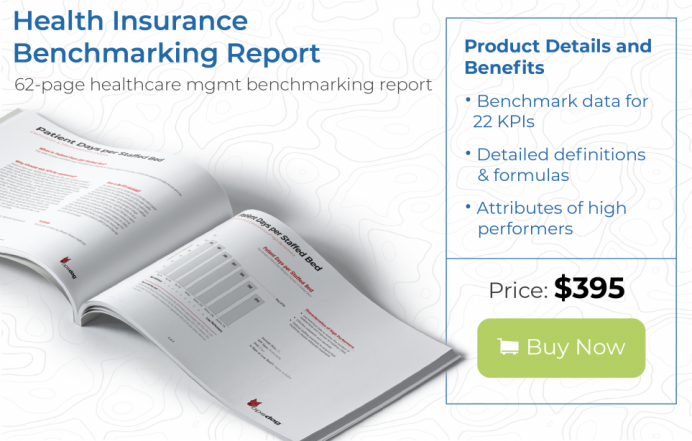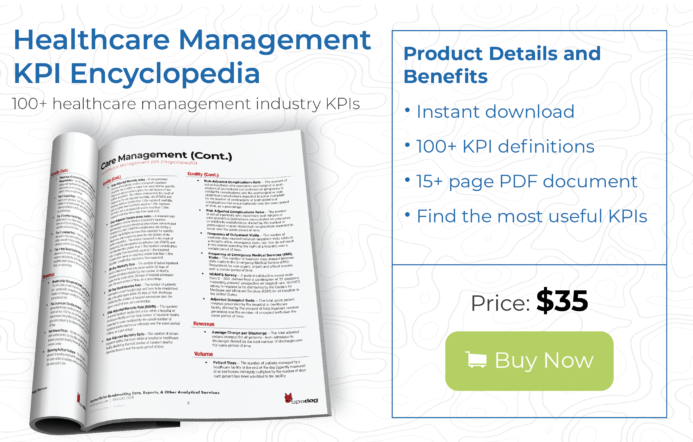Health insurance companies generate the bulk of their profits by charging premiums to policyholders, or members, and then investing those premiums into interest-earning assets. But to increase the amount available for investment, insurers need to work hard to deliver good service that makes policyholders happy while keeping their operating costs in check. Key performance indicators (KPIs) allow health insurers to track both.
What are Health Insurance KPIs?
Health insurance companies deliver health insurance plans to individuals, businesses, and groups, including enrolling members, processing claims, managing accounts, and providing various forms of health-related assistance such as smoking cessation programs and diabetes education to members. They also work closely with healthcare providers such as physicians, hospitals, and pharmacies to negotiate rates.
As such, health insurance key performance indicators (KPIs) can be defined as metrics related to revenue, productivity, risk, and more that serve as a baseline for Health Insurance companies to use for comparison against peers or goals in a variety of different business processes.
If a member submits a claim, the health insurance company works with both the member and the provider to ensure that the provider is paid and the member pays the correct amount based on their deductible, co-pay, or co-insurance.
As an industry, health insurance is unique. Unlike manufacturing or retail that has to put out cash upfront for inventory, health insurers collect policy premiums before actually having to deliver a product. So while there are some general KPIs that apply to all businesses, health insurance company metrics are focused on items like the cost of claims or the percentage of members who have filed claims.
The appropriate Health Insurance KPIs, both financial and non-financial, allow you to measure where the insurer is today and track progress toward the desired goal.
Benefits of Using KPIs in a Health Insurance Company
Obviously, the more premiums collected and the fewer claims paid, the more potential investments health insurers can make which directly impacts revenues. But health insurance has a lot of moving parts, with multiple steps for tasks such as claims processing and underwriting. There’s also much outreach to healthcare providers.
Any process that has multiple steps is a prime candidate for measuring and tracking KPIs. For instance, KPIs can identify areas that could benefit from more standardized and consistent processes to streamline and automate repetitive tasks. Do you need more stringent billing and coding procedures for paying claims? Are employees wasting time on manual data entry or having to reach out to members multiple times to complete a claim?
Health insurance KPIs can also highlight issues with marketing, policy acquisition, and member retention. Is there any part of your products or services that members are unhappy with that may spur them to change insurers?
KPIs can also help you determine the right staffing levels. If you find that you have a larger number of staff compared to your peers, KPIs can help you narrow down the root cause of over-staffing. Perhaps employees need better training, consistent job aids, or better technology tools to become more productive.
Health Insurance KPI Examples
Like any industry, health insurers must focus on keeping operating costs as low as possible while still meeting appropriate service levels. The following five health insurance KPIs measure the efficiency and productivity of staff as well as member and healthcare provider satisfaction.
KPI Metric #1: Health Plan Members per Employee
The number of health plan members per employee gives you an indication of whether you are over or under-staffed. Too many employees versus members results in high costs, yet too few employees could mean that members aren’t receiving the service levels they expect. Or, you may need to beef up marketing to keep and attract more members.
To calculate, divide the number of health plan members by the number of part-time and full-time employees. Count individual members regardless of whether they are part of an individual, group, or family plan.
KPI Metric #2: New Member Enrollment Cycle Time
Taking too many days to enroll a new member not only negatively impacts member satisfaction, but health insurer operating costs go up. To speed up member enrollment time, make sure the enrollment instructions are clear so that applications are correctly completed and that employees are well-trained to handle enrollment.
To calculate, divide the number of business days to manually enroll a new member by the number of new member manual enrollments. Count only business days from when the member applied for the plan to the approval date.
KPI Metric #3: Benefit Accuracy Rate
Health insurance benefits can be confusing to members in the best of times; if you get the patient responsibility amount wrong on a claim, members are understandably frustrated. Errors mean less member satisfaction and more rework for the insurer. If the benefit accuracy rate is low, consider pre-adjudicating claims or more rigorously determining patient responsibilities for co-pays, deductibles, and co-insurance.
To calculate, divide the number of correct patient responsibility amounts by the number of amounts sent to members, as a percentage.
KPI Metric #4: ERA Transparency Rate
Health insurers send electronic remittance advice (ERA) messages to healthcare providers to inform them of claim status. If the claim was denied, the insurer includes the reasons why—such as missing information or if the patient wasn’t eligible for services—and how to correct any issues. If ERA denial reasons and action items aren’t clear, the back and forth between healthcare providers and the insurer slows down the claims process, creates additional work for both, and can even escalate into costly disputes.
KPI Metric #5: Revenue per Health Plan Member
Oft-used as a general measure of overall health insurer profitability, revenue per member can identify issues with business growth and value, perhaps due to poor member services or member retention. It can also indicate that the insurer is not effectively investing premiums to produce returns.
To calculate, divide total revenue by the number of members.
To calculate, divide the number of ERA messages with clear reasons and action items by the number of ERA denial messages sent, as a percentage. Count each ERA message only once, even if it includes more than one reason code.
Final Thoughts
Health insurance companies have a unique business model, and although some more generic KPIs are useful, insurers tend to focus on KPIs that evaluate processes and highlight opportunities to streamline workflows.
For a full list of health insurance key performance indicators other related insurance key performance indicators, download our Health Insurance KPI Encyclopedia here.
If you require additional assistance in developing a KPI inventory to benchmark health insurance agency performance then you may find our Health Insurance benchmarking report helpful. For even more information on our Benchmarking Research and business intelligence implementation services, contact us here. OpsDog can help your health insurance company build a KPI tracking plan and provide you with presentation-ready, high-quality deliverables.




